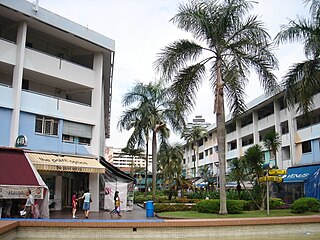
Clementi is a planning area and residential town located at the easternmost fringe of the West Region of Singapore. The town borders Bukit Batok to the north, Bukit Timah to the northeast, Queenstown to the east and Jurong East to the west.

Tampines is the regional centre of the East Region of Singapore. With a population of 265,340 living across its five subzones, it is the second-most populous planning area in Singapore, according to the DOS Population Trends 2022. It is home to approximately 5% of Singapore's population. Tampines is bordered to the west by Bedok and Paya Lebar, to the north by Pasir Ris, to the east by Changi, and to the south by the Straits of Singapore. Situated in the historical region of Tanah Merah, its present-day terrain is particularly flat due to the large-scale sand quarrying in the 1960s.
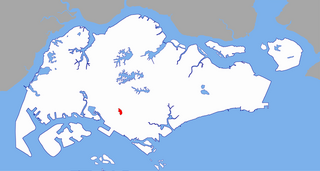
Ghim Moh is a neighbourhood located in Queenstown, Singapore. The estate consists of 28 blocks.
Simei is an estate located in Tampines Town. Eastern part of Singapore. The name Simei is pinyin for "Four Beauties" in Chinese. Formerly known as Tampines South, it was officially renamed to Simei in 1985.

Simei MRT station is an above-ground Mass Rapid Transit (MRT) station on the East–West line in Tampines planning area, Singapore, at the centre of Simei housing estate flanked by Simei Street 1 and Simei Street 3 next to Eastpoint Mall. This station primarily serves Simei, a residential estate part of the larger Tampines New Town.

Queenstown is a planning area and satellite residential town situated on the south-westernmost fringe of the Central Region of Singapore. It borders Bukit Timah to the north, Tanglin to the northeast, Bukit Merah to the east and southeast, as well as Clementi to the northwest and west. Its southern and southwesternmost limits are bounded by the Pandan Strait.

Tampines MRT station is a Mass Rapid Transit (MRT) interchange station on the East West (EWL) and Downtown (DTL) lines in Tampines, Singapore. Situated at the heart of the Tampines town centre next to Tampines Avenue 4, Tampines Central 4 and Tampines Central 5, it is in close proximity to the Tampines and Tampines Concourse bus interchanges. The station also serves the surrounding retail developments of Tampines Mall, Tampines One and Century Square.
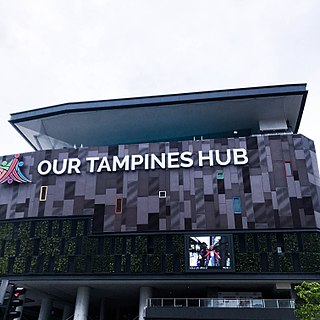
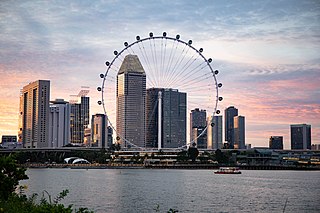
This article shows the notable future developments in Singapore. Most of them are currently under construction with most to be completed within the next five years.
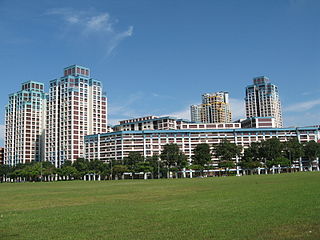
Public housing in Singapore is subsidised, built and managed by the Government of Singapore. Starting in the 1930s, the country's first public housing was built by the Singapore Improvement Trust (SIT) in a similar fashion to contemporaneous British public housing projects, and housing for the resettlement of squatters was built from the late 1950s. In the 1960s, under the SIT's successor the Housing and Development Board (HDB), public housing consisting of small units with basic amenities was constructed as quickly and cheaply as possible at high densities, and was used for resettlement schemes. From the late 1960s, housing programmes focused more on quality, public housing was built in new towns, and a scheme allowing residents to lease their flats was introduced. Throughout the 1970s and 1980s, more public housing options were provided for the middle class and efforts to increase community cohesion within housing estates were made. From the 1990s, the government began portraying public housing as an asset, introducing large-scale upgrading schemes and loosening regulations on the resale of public housing while additional housing programmes for the sandwich classes and elderly residents were introduced. Rising housing prices led to public housing being seen as an investment from the 2000s, and new technologies and eco-friendly features were incorporated into housing estates.

Fahrudin Mustafić is a retired Singaporean professional footballer who spent most of his playing career as a centre-back for S-League side Tampines Rovers FC and retired at the end of the 2018 season. Born in Serbia, he represented the Singapore national team. He also has a Bosnian citizenship.
Teban Gardens is a residential precinct located in Jurong East, Singapore. Immediately north of Pandan Reservoir, it comprises exclusively public housing built by the JTC Corporation and Housing and Development Board.

Fazrul Nawaz bin Shahul Hameed is a Singapore former international footballer who last played as a striker or second-striker for Singapore Premier League club Tampines Rovers and the Singapore national team. He is the current assistant coach for the Singapore women National team.
Pandan Gardens is a housing estate which is part of Jurong East New Town in the West Region of Singapore. Immediately north of Pandan Reservoir and adjacent to Teban Gardens, it comprises exclusively public housing built by the JTC Corporation and Housing and Development Board. Its namesake road connects Jurong Town Hall Road to West Coast Road.

Tan Chuan-Jin is a Singaporean former politician and brigadier-general who served as Speaker of the Parliament between 2017 and 2023. He also served as Minister for Manpower between 2014 and 2015, and Minister for Social and Family Development between 2015 and 2017.
Park Kang-Jin is a South Korean association footballer.

Tampines Meridian Junior College (TMJC) is a junior college in Singapore, founded in 2018, offering two-year pre-university courses leading up to the Singapore-Cambridge GCE Advanced Level examination. It was founded after the merger of Tampines Junior College and Meridian Junior College, which was prompted by a decrease in student enrolment.